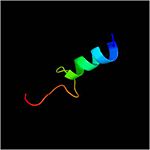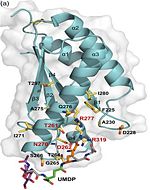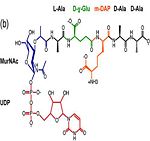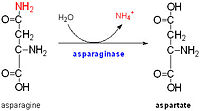Mycobacterium tuberculosis ArfA Rv0899
From Proteopedia
(Difference between revisions)
| Line 33: | Line 33: | ||
Its functions in acid stress protection and [peptidoglycan][http://en.wikipedia.org/wiki/Peptidoglycan] binding site <scene name='61/612805/Peptidoglycan_binding_site/1'>(R277, R319, T261, D262, N270)</scene> suggest a link between the acid stress response and the physicochemical properties of the mycobacterial cell wall. These residues are strictly conserved in the OmpA -like family <ref>PMID: 22206986 </ref>. | Its functions in acid stress protection and [peptidoglycan][http://en.wikipedia.org/wiki/Peptidoglycan] binding site <scene name='61/612805/Peptidoglycan_binding_site/1'>(R277, R319, T261, D262, N270)</scene> suggest a link between the acid stress response and the physicochemical properties of the mycobacterial cell wall. These residues are strictly conserved in the OmpA -like family <ref>PMID: 22206986 </ref>. | ||
| - | [[Image:123456.jpg| | + | [[Image:123456.jpg|150px]] |
| - | [[Image:MurNac11.jpg| | + | [[Image:MurNac11.jpg|150px]] |
The protein Rv0899 ArfA is restricted to pathogenic Mycobacteria associated with tuberculosis and, thus, is an attractive candidate for the development of anti-tuberculosis chemotherapeutic agents.Two M. tuberculosis H37Rv genes (Rv0900 and Rv0901) adjacent to Rv0899 also encode putative membrane proteins, and are found exclusively in association with Rv0899 in the same pathogenic mycobacteria, suggesting that the three may constitute an operon dedicated to a common function. The operon is necessary for rapid ammonia secretion and adaptation of M. tuberculosis to acidic environments in vitro but not in mice. | The protein Rv0899 ArfA is restricted to pathogenic Mycobacteria associated with tuberculosis and, thus, is an attractive candidate for the development of anti-tuberculosis chemotherapeutic agents.Two M. tuberculosis H37Rv genes (Rv0900 and Rv0901) adjacent to Rv0899 also encode putative membrane proteins, and are found exclusively in association with Rv0899 in the same pathogenic mycobacteria, suggesting that the three may constitute an operon dedicated to a common function. The operon is necessary for rapid ammonia secretion and adaptation of M. tuberculosis to acidic environments in vitro but not in mice. | ||
Revision as of 15:00, 19 January 2015
| |||||||||||




